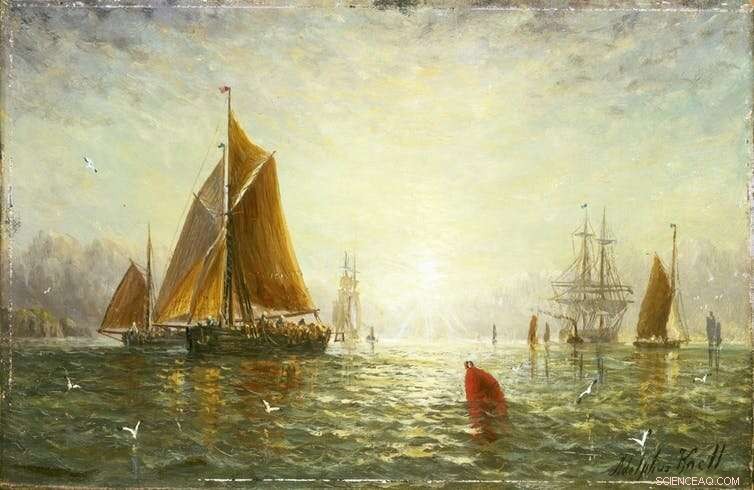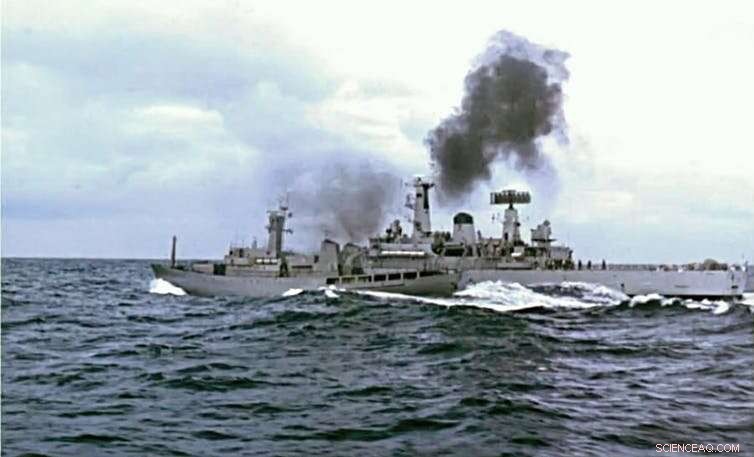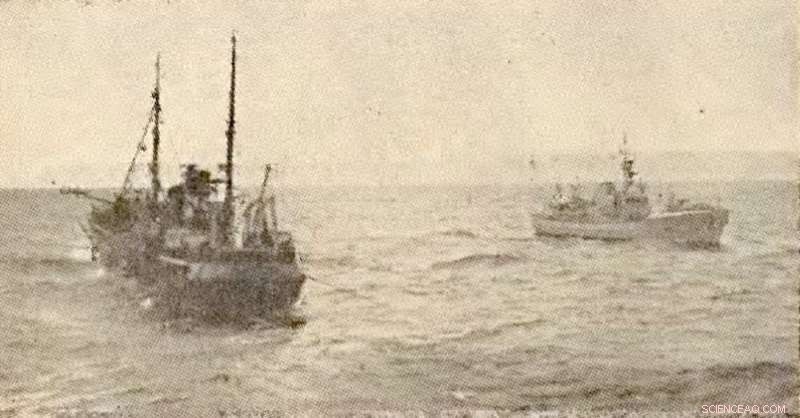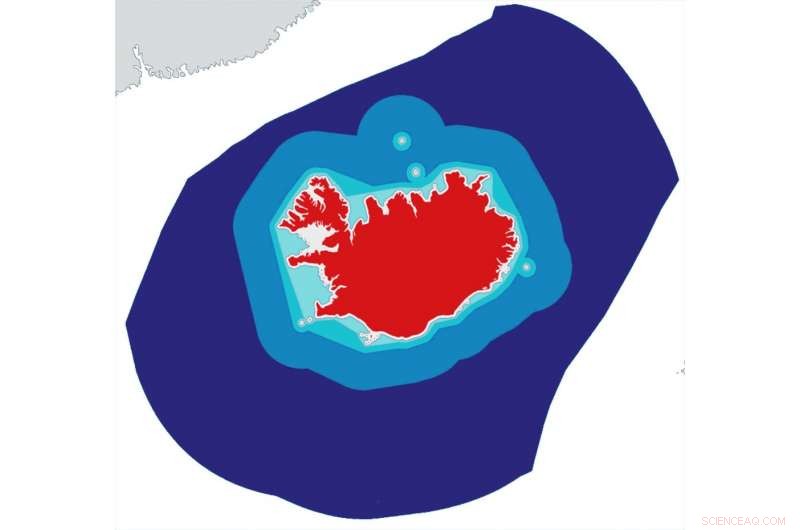
Un chalutier Brixham du XIXe siècle par William Adolphus Knell. Crédit :National Maritime Museum/Wikipédia
Les bateaux britanniques étaient en infériorité numérique d'environ huit contre un par les Français. Peu de temps après, il y a eu des collisions et des projectiles ont été lancés. Les Britanniques ont été contraints de battre en retraite, retour au port avec des vitres cassées mais heureusement pas de blessés.
Le conflit à l'origine de cette escarmouche entre pêcheurs britanniques et français dans la baie de Seine fin août 2018 a rapidement été surnommé la "guerre de la coquille Saint-Jacques" dans la presse. Les Français avaient essayé d'empêcher les dragues britanniques de pétoncles de pêcher légalement dans les eaux nationales françaises. Mais l'incident a révélé des tensions qui couvent depuis de nombreuses années.
Dans le cadre de la politique commune de la pêche (PCP) de l'Union européenne, les pêcheurs britanniques avaient le droit légal de pêcher dans ces eaux, comme l'ont fait tous les bateaux d'un État membre de l'UE. La complication est venue d'une réglementation française qui empêchait les bateaux locaux de pêcher dans ces eaux entre le 16 mai et le 30 septembre de chaque année, afin de permettre aux stocks de se reconstituer après la récolte annuelle. Mais dans le cadre de la PCP, un pays de l'UE n'a aucune autorité pour empêcher la flotte d'un autre État membre de pêcher dans ses eaux.
Cette bizarrerie de la PCP a laissé les pêcheurs français incapables de draguer les coquilles Saint-Jacques jusqu'au 1er octobre. et forcés de rester les bras croisés pendant que les flottes d'autres pays récoltaient ce qu'elles considéraient comme une ressource française dans les eaux françaises. Lorsque les bateaux britanniques sont arrivés, les pêcheurs français ont endossé le rôle de gardiens de leur ressource, actions qu'ils croyaient justifiées mais considérées par l'industrie de la pêche britannique comme illégales.
Cet incident dans un petit coin d'une mer commune de l'UE a été réglé en quelques semaines grâce à un nouvel accord sur la façon dont les deux pays partageraient la récolte de pétoncles. Mais les tensions sous-jacentes que la PCP a créées sur le partage des ressources nationales sont bien plus profondes, avec le sentiment que les règles ne permettent pas une utilisation équitable des mers.
Ce sentiment d'injustice s'est manifestement exprimé dans le rôle que la pêche a joué dans la décision de la Grande-Bretagne de quitter l'UE. Les militants ont promis que "reprendre le contrôle" des eaux britanniques permettrait au pays de relancer son industrie de la pêche en déclin depuis longtemps et les communautés qui en dépendent.
Pourtant, quel que soit l'impact de la PCP sur les pêcheurs britanniques, leur avenir après le Brexit dépend beaucoup de tout futur accord commercial que le gouvernement négocie avec l'UE. Et l'histoire de la façon dont la Grande-Bretagne a réagi à des conflits sur les droits de pêche bien plus importants que la guerre du pétoncle n'augure rien de bon pour l'industrie.
Le début de la baisse
Les recherches sur l'activité de pêche montrent que le déclin de l'industrie de la pêche britannique a commencé bien avant la création de toute politique européenne de la pêche. En réalité, ses origines ultimes peuvent être attribuées à une source surprenante :l'expansion des chemins de fer à la fin du 19e siècle.
Chalutage, sous la force de la voile, existait depuis plus de 500 ans. Mais sans réfrigération, le poisson ne pouvait être livré à la vente que dans des zones proches des ports. L'arrivée du réseau ferroviaire signifiait que le poisson pouvait être transporté à l'intérieur des terres vers les grandes villes.
Pour mieux répondre à cette demande croissante, les chalutiers à vapeur ont commencé à remplacer les chalutiers à voile à partir des années 1880. La puissance de ces bateaux à vapeur a considérablement augmenté la portée du chalutage et leur a permis de chaluter plus longtemps et plus loin du port tout en remorquant des filets plus gros. Les chalutiers à vapeur britanniques s'aventuraient plus loin de la Grande-Bretagne à la recherche de poisson, les zones de pêche s'étendant jusqu'au Groenland, le nord de la Norvège et la mer de Barent, l'Islande et les îles Féroé.
Mais dès 1885, des inquiétudes ont été exprimées quant au fait que cette avancée technologique avait un impact négatif à la fois sur les stocks de poissons et leur habitat. Les preuves tirées des registres de l'activité de pêche montrent que cette amélioration de la technologie et l'augmentation de la taille de la flotte de pêche étaient clairement à l'origine de l'augmentation des débarquements.
Le boom de la pêche que les chemins de fer avaient déclenché s'est avéré insoutenable, et la surpêche qui en résulterait entraînerait finalement l'industrie dans un ralentissement à long terme. Après des décennies de pêche de plus en plus, les débarquements ont finalement commencé à décliner après la Seconde Guerre mondiale, une tendance qui s'est poursuivie tout au long de la seconde moitié du 20e siècle et dans le nouveau millénaire.
Pour compenser, la taille et la puissance de la flotte ont continué d'augmenter à mesure que davantage d'efforts étaient nécessaires pour capturer des poissons de plus en plus rares. A partir de la fin des années 1950, la quantité de poisson débarquée par unité de puissance a diminué plus rapidement que les débarquements de poisson, la flottille continuant à déployer de plus en plus d'efforts pour maintenir la taille des captures. Cependant, cet effort a été vain et, en 1980, les captures étaient tombées à leur plus bas niveau en un siècle.

L'Odinn islandais et le HMS Scylla s'affrontent dans l'Atlantique Nord pendant la « troisième guerre de la morue » dans les années 1970. Crédit :Isaac Newton/www.hmsbacchante.co.uk
Guerres de la morue
La surpêche n'était pas la seule raison du déclin, toutefois. La baisse des stocks de poissons combinée à l'amélioration de la portée et de la puissance de la flotte dans les années d'après-guerre a conduit les pêcheurs britanniques à rechercher de nouvelles eaux, avec plus de bateaux s'éloignant du Royaume-Uni pour pêcher suffisamment de poisson pour répondre à la demande intérieure. Et ce chalutage à longue distance a mis la flotte britannique en conflit avec l'Islande.
Les pêcheurs britanniques avaient pêché ces eaux depuis le 15ème siècle. Cependant, L'industrie de la pêche islandaise a commencé à ressentir cela lorsque les chalutiers à vapeur ont commencé à pêcher au large de l'Islande à la fin du XIXe siècle. Cela a conduit à des accusations selon lesquelles les chalutiers britanniques endommageaient les zones de pêche et épuisaient les stocks. En 1952, L'Islande a déclaré une zone de quatre milles autour de son pays pour arrêter la pêche étrangère excessive, bien que les poissons ne s'en tiennent pas aux limites créées par l'homme et que les stocks puissent encore s'épuiser en dehors de cette zone. La décision de l'Islande a suscité une réaction du Royaume-Uni, qui interdisait l'importation de poisson islandais. En tant que marché d'exportation majeur pour l'industrie la plus importante d'Islande, ils espéraient que cela les amènerait à la table des négociations.
En 1958, sur fond de diplomatie ratée, L'Islande a étendu cette zone à 12 milles et interdit aux flottes étrangères de pêcher dans ces eaux, au mépris du droit international. Cela a conduit à la première de ce qui est devenu la guerre de la morue – un acte en trois étapes qui a duré près de 20 ans.
Pendant la première guerre de la morue, Des frégates de la Royal Navy ont accompagné la flotte britannique dans la zone d'exclusion islandaise pour poursuivre leur pêche. Un jeu du chat et de la souris s'ensuivit entre les navires des garde-côtes islandais et les chalutiers britanniques. En réponse aux tentatives de saisie, les chalutiers ont éperonné les navires des garde-côtes et les garde-côtes ont menacé d'ouvrir le feu, bien que des incidents majeurs aient été évités.
En 1961, les deux pays sont finalement parvenus à un accord qui a permis à l'Islande de conserver sa zone de 12 milles. En retour, le Royaume-Uni a obtenu un accès conditionnel à ces eaux.
En 1972, cependant, la surpêche en dehors de cette limite s'était aggravée et l'Islande a étendu sa zone exclusive à 50 milles puis trois ans plus tard, à 200 milles. Ces deux mouvements ont conduit à plus d'affrontements entre les chalutiers islandais et les navires d'escorte de la Royal Navy, respectivement surnommés les deuxième et troisième guerres de la morue.
Les navires des garde-côtes islandais remorquaient des dispositifs conçus pour couper les câbles de chalut en acier (aussières) des chalutiers britanniques - et les navires de tous les côtés ont été impliqués dans des collisions délibérées. Bien que ces affrontements aient été pour la plupart sans effusion de sang, a British fisher was seriously injured when he was hit by a severed hawser and an Icelandic engineer died while repairing damage to a trawler that had clashed with a Royal Navy frigate.
In January 1976, British naval frigate HMS Andromeda collided with Thor, an Icelandic gunboat, which also sustained a hole in its hull. While British officials called the collision a "deliberate attack", the Icelandic Coastguard accused the Andomeda of ramming Thor by overtaking and then changing course. Eventually NATO intervened and another agreement was reached in May 1976 over UK access and catch limits. This agreement gave 30 vessels access to Iceland's waters for six months.
NATO's involvement in the dispute had little to do with fisheries and a large amount to do with the Cold War. Iceland was a member of NATO, and therefore aligned to the US, with a substantial US military presence in Iceland at the time. Iceland believed that NATO should intervene in the dispute but it had up until that point resisted. Popular feeling against NATO grew in Iceland and the US became concerned that this strategically important island nation – which allowed control of the Greenland Iceland UK (GIUK) gap, an anti-submarine choke point – could leave NATO and worse, align itself with the Soviets.
Amid protests at the US military base in Iceland demanding the expulsion of the Americans, and growing calls from Icelandic politicians that they should leave NATO, the US put pressure on the British to concede in order to protect the NATO alliance. The agreement brought to an end more than 500 years of unrestricted British fishing in these waters.
The loss of these Atlantic fishing grounds cost 1, 500 jobs in the home ports of the UK's distant water fleet, concentrated around Scotland and the north-east of England, with many more jobs lost in shore-based support industries. This had a significant negative impact on the fishing communities in these areas.
The UK also established its own 200-mile limit in response to Iceland's exclusion zone. These limits were eventually incorporated in the 1982 United Nations Convention on the Law of the Sea, giving similar rights to every sovereign nation. The creation of these "exclusive economic zones" (EEZ) was the first time that the international community had recognised that nations could own all of the resources that existed within the seas that surrounded them and exclude other nations from exploiting these resources.
The UK now owned the rights to the 200-mile zone around its islands, which contained some of the richest fishing grounds in Europe but up until this point the principle of "open seas" had existed, with Britain its most vocal champion. Fishing nations, had fished the high seas within 200 miles of their own and others coasts for centuries and now were restricted to their own.

British trawler Coventry City passes Icelandic Coastguard patrol vessel Albert off the Westfjords in 1958 during the first Cod War. Credit:Kjallakr/Wikipedia
Economic trade offs
Britain's Exclusive Economic Zone (EEZ), cependant, wasn't that exclusive.
On joining the European Economic Community (the forerunner to the EU) in 1972, the UK had agreed to a policy of sharing access to its waters with all member states, and gaining access to the waters of other countries in return. The UN convention effectively gave the EEC one giant EEZ.
The UK government was willing to enter into the agreement as fisheries were one part of overall negotiations that would allow the UK to export goods and services to the European continent with significantly reduced trade barriers.
Although the fishing industry is of high local importance to fishing communities, it is relatively unimportant to the UK economy as a whole. En 2016, the UK fishing industry (which includes the catching sector and all associated industries) was valued at £1.6 billion, against £1.76 trillion for the UK economy as a whole – or just under 1%. The UK's trade with the EU, both import and export, stands at £615 billion a year in comparison.
Enter the Common Fisheries Policy
En 1983, the Common Fisheries Policy was adopted, introducing management of European waters by giving each state a quota for what it could catch, based on a pre-determined percentage of total fishing opportunities. This was known as "relative stability" and was based on each country's historic fishing activity before 1983, which still determines how quotas are allocated today.
The formula that the EEC adopted, based on historic catches, is one of most contentious parts of the CFP for the UK. Many fishers have stories of the years running up to 1983, where foreign vessels increased their fishing activity in UK waters in order to secure a larger share of these fish in perpetuity. Although there is little evidence to support these views, it demonstrates the level of distrust in both the system, and foreign fishers, from the outset.
Par conséquent, only 32% of fish caught in the UK EEZ today is caught by UK boats, with most of the remainder taken by vessels from other EU states, Norway and the Faroe Islands (who have also joined the CFP). Par conséquent, non-UK vessels catch the remaining 68%, about 700, 000 tonnes, of fish a year in the UK EEZ.In return, the UK fleet lands about 92, 000 tonnes a year from other EU countries' waters.
Joining the CFP did not cause a decline in UK fish landings. Cependant, in its early days, it did nothing to stop it. Fish landings continued to decline – and along with this, the industry itself contracted, using improved technology to offset the decline in stocks. Through the 1980s and into the early part of this century the imbalance – enshrined in the relative stability measure of the CFP – has led to the view that the CFP doesn't work in the UK's interests. Rather it allows the rest of the EU to take advantage of the country's fish stocks.
The CFP's quota system, while credited for helping the industry survive (and even reverse the collapse in fish stocks), is now seen as burdensome and preventing further growth.
A recent academic analysis of the current performance of the CFP showed it was not improving the management of the fish stock resources in any of its 17 criteria and was actually making things worse in seven areas.
Par exemple, a 2013 reform of the CFP introduced the landing obligation, the so-called "discard ban", that was designed to stop vessels discarding fish (bycatch) caught alongside the species they were targeting. Environmentalists, and campaigns backed by celebrities such as Hugh Fearnley-Whittingstall, have long voiced concerns over incidents of bycatch being dumped by fishers operating under the quota system.
This policy is now seen as potentially disastrous by some representatives of Britain's North Sea fishing fleet, as so many different types of fish live in the waters and bycatch is common and often unavoidable. They are concerned that boats would be forced to fill their holds with commercially worthless fish and return to port early. Or by exhausting their quota for some species early in the season, they would be forced to stay in port for the rest of the year, despite having quotas available for other species. Evidence given to the House of Lords suggests that this situation has not arisen as non-compliance and a lack of enforcement has undermined the discard ban.

Map of the Icelandic EEZ, and its expansion. Red =Iceland. White =internal waters. Light turquoise =four-mile expansion, 1952. Dark turquoise =12-mile expansion (current extent of territorial waters), 1958. Blue =50-mile expansion, 1972. Dark blue =200-mile expansion (current extent of EEZ), 1975. Credit:Kjallakr/Wikipedia, CC BY-SA
When we interviewed fishers in north-east Scotland in 2018, we found many feared such blanket management across the entire EU would continue to damage their industry because it simply does not take into account the local environment that they work in.
Brexit
The depth of feeling among the UK fishing community was illustrated by the voting figures for the EU referendum in June 2016.
In Banff and Buchan, the constituency in Scotland containing Peterhead and Fraserburgh – the largest and third largest fishing ports in the UK respectively – 54% of people voted to leave the EU, with the size of the fishing industry given as the reason for this result. The result compared to 52% for the whole of the UK and just 38% for Scotland. A survey of members of the UK fishing industry before the vote indicated that 92.8% of correspondents believed that doing so would improve the UK fishing industry by some measure.
But will Brexit really bring the fishing revival so many have promised and hoped for? British politicians have promised a renaissance in UK fishing after leaving the EU. A Fisheries Bill was launched by the environment secretary, Michael Gove, with an aim to "take back control of UK waters". Cependant, no definitive plan to remove the UK from the CFP in a transition deal has been made, nor has the industry been given any answers on future access for EU vessels, the apportionment of any new quota – if indeed the quota system remains as it is – the rules that they will be operating under, or even a date on which this will come into effect.
The UK government is seen by many in the fishing industry to be acting against their interests in pursuit of wider goals, for example by using the industry as a bargaining chip in wider UK trade negotiations with the EU.
The fishing industry's distrust of the government has a long tail:many believe they were sacrificed in 1973 by the then prime minister, Edward Heath, in order to secure access to the single market.
A soured relationship
Ironiquement, despite the fishing industry's support for Brexit and the popular campaign promises, our research suggests fishers don't simply want to close British waters to European fleets. We interviewed people who were sympathetic to their fellow fishers from abroad and did not wish to see businesses and livelihoods lost. They favour a re-balancing of quotas over time to allow EU vessels to adapt to the change, with all vessels having to adhere to UK rules. This would avoid any situations similar to the Scallop War by ensuring that all vessels with a quota have to abide by local restrictions.
The EU is the main export market for UK fish and fisheries products accounting for 70% of UK fisheries exports by value. Valued at £1.3 billion, this trade far exceeds the £980m value of fish landed in the UK, due to the added value from the processing sector. Some of the remaining 30% of exports that go to countries outside of the EU are governed by trade agreements negotiated by the EU that reduce trade barriers. So the single market, and additional trade agreements, are crucial to the success of the UK fishing industry.
This reliance on trade into the EU puts the industry in a position where unilaterally preventing access to UK waters would likely be met by reciprocal trade barriers and tariffs. This would increase the cost of their product, while reducing access to their biggest market. The question for the government, alors, is how to balance a political issue against an economic one?
The issue centres on the word "control". If the UK has control of its waters that would simply mean that its government has the power to decide on anything from keeping fishing within UK waters purely for UK vessels, to remaining in or re-entering the CFP, or all points in between. Until the deals are negotiated and signed, the industry will remain in a limbo that has reopened old wounds and reignited distrust in the UK government.
Cet article est republié à partir de The Conversation sous une licence Creative Commons. Lire l'article original. 